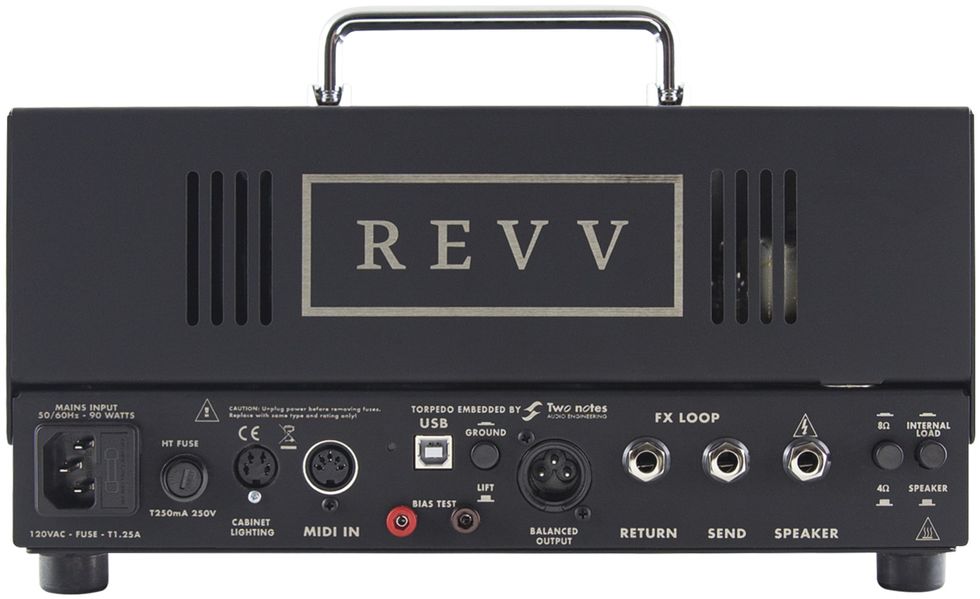RatingsPros:A direct recording preamp and a proper 2 x 6V6 combo. Built-in Two Notes cabinet emulations. Innovative design. Works beautifully with gain pedals and ambient effects. Cons: Shallow depth of field on clean, dry tones. Street: $1,199 Revv D20 revvamplification.com | Tones: Ease of Use: Build/Design: Value: |
How’s this for a cool idea? An all-tube preamp with a nice assortment of built-in cabinet emulations for direct recording. But’s it’s also a 20-watt amp head fueled by two 6V6 power tubes and capable of driving speaker cabinets. And oh—it’s roughly the size of a toaster and weighs about as much as your guitar. Yup, that pretty much describes the D20 from Canada’s Revv Amplification. It’s an ingenious concept, expertly realized, and enhanced by many clever and useful features.
Familiar Feel
The amp’s front panel controls are straightforward: gain, treble/mid/bass, and master volume. The gain control employs a push/pull pot, with hotter, more distorted sounds in the out position. There’s also a headphone-out jack with a level control, a switch to lower the amp’s power from 20 to 4 watts, and a rotary switch to select one of six onboard cabinet emulations. (More on those in a moment.)
To use the D20 without a cabinet, you connect to a DAW or mixing desk via the rear-panel XLR out. There’s also a standard 1/4" jack for connecting a cab. The D20 is a reactive load box, so you don’t need to connect any speakers. But if you do, you can drive a cab and record your direct signal simultaneously. The rear panel also includes a mono effects loop (buffered and in series), a USB jack for installing and editing speaker emulations via computer, and external terminals for biasing the power tubes without disassembling the chassis. There’s also an old-school MIDI-in jack for remotely switching cab emulations.
Damn, the Torpedo!
According to Revv, the D20 is the first amplifier to integrate Two Notes’ Torpedo cabinet emulation software. Torpedo products, which combine speaker cabinet impulse responses with power amp and room emulations, have acquired a fervid following among metal and hard rock players. The D20 offers a sort of “Torpedo light,” with six emulations (rather than Torpedo’s usual 32) selectable via that front-panel switch.
There are no onboard controls to adjust the Torpedo sounds, but you can edit their parameters using a free Two Notes app. You can also purchase additional cabinet IRs through the app, and store up to 128 of them within the D20. But you can still only access six of them without connecting to a computer or MIDI controller.
Revv It Up
My audio clips demo the D20 in its various roles. For Clip 1, I recorded direct and dry, with no downstream sweetening. I play six clean-toned phrases—one for each cab-emulation preset. Any reverb you hear is part of the Torpedo emulation. In Clip 2 I do the same, with the amp gain knob at higher settings in its hot position. To my ear, the tones are realistically amp-like, but they sound a bit two-dimensional compared to a well-miked cabinet. (I’ve had similar reactions to the other micro-format amps I’ve reviewed.) Still, I can imagine them working in a mix context.
The tone controls have relatively wide ranges, and you sometimes encounter excessively woofy or prickly sounds. It’s easy to compensate for this, but don’t be surprised if you use the tone controls more aggressively than usual.

Wet and Wild
The D20 has ample headroom. Ambient effects retain their detail. Chords and notes are well-defined, even when goosing the input with fuzz and distortion pedals. For audio Clip 3 I patched a Eventide Rose pedal into the effect loop. The complex reverbs and delays come across clearly, and there’s a nice sense of space, even as heard here in mono. (My test instrument is a DIY guitar with vintage-output humbuckers.)
In Clip 4, I add a couple of homemade overdrive and fuzz pedals. Notes and chords have strong definition and aggressive attack, even at ultra-high gain settings. In Clip 5, I connect the D20 to a cabinet and mike one of its 50-watt Celestion Creamback speakers with a Royer R-121 ribbon mic. It sounds an awful lot like the direct sounds—testimony to the realism of the Torpedo emulations.
A light but sturdy aluminum shell protects the amp’s components while restricting its weight to a mere nine pounds. The tubes, Hammond power transformer, and Classic Tone output transformer protrude from the chassis as on traditional amps. Inside is a circuit board housing both conventional passive components and the Torpedo processors. Everything looks solid and reliable.
The Verdict
The Revv D20 is an innovative product with many possible applications. To my ear, it’s best-suited for high-gain tones—especially with ambient effects added. The D20 could live on a studio desktop, driving cabinets while serving as a direct recording preamp. It would also be valuable whenever size and weight are issues. It could easily fit into an overhead bin or beneath a seat on a flight. The price is fair too, considering the D20’s North American manufacture and the formidable R&D required to produce this innovative and useful tool.








![Rig Rundown: Russian Circles’ Mike Sullivan [2025]](https://www.premierguitar.com/media-library/youtube.jpg?id=62303631&width=1245&height=700&quality=70&coordinates=0%2C0%2C0%2C0)


























